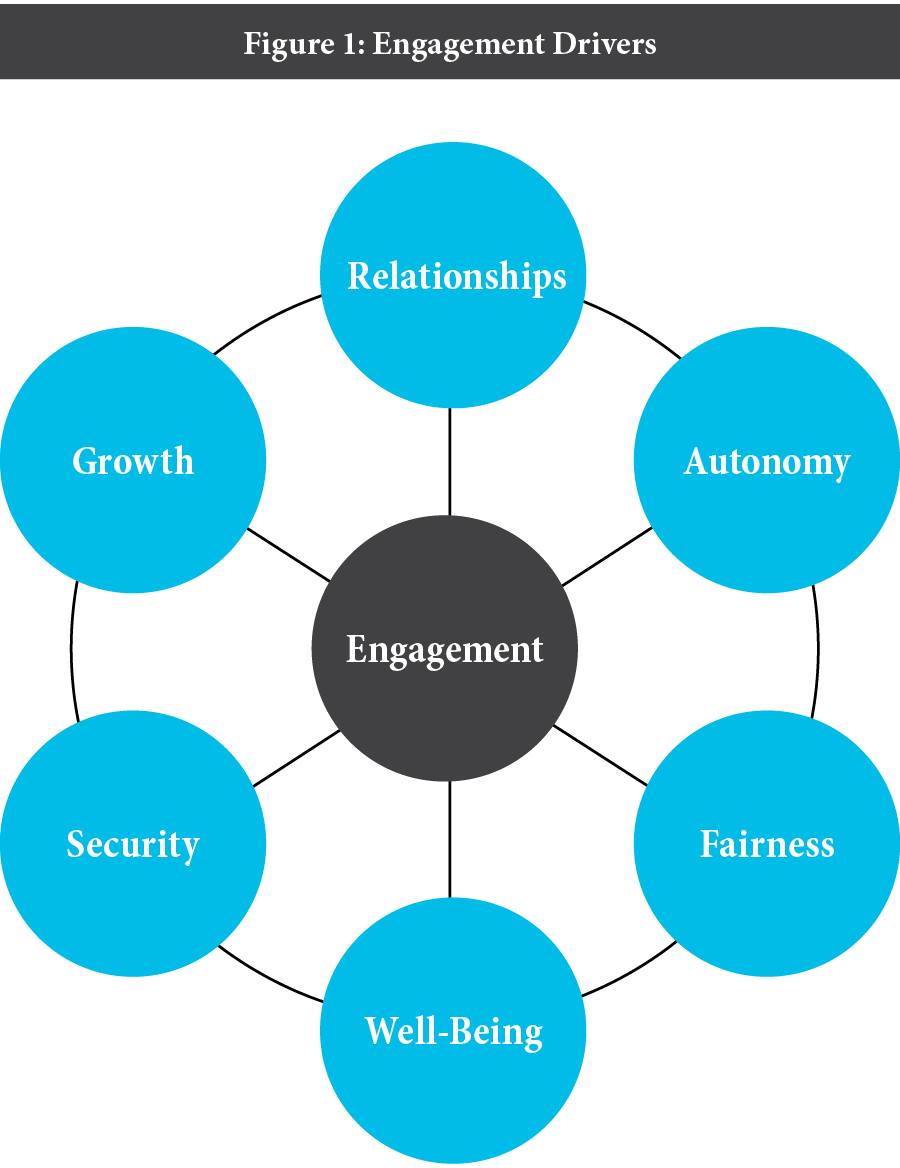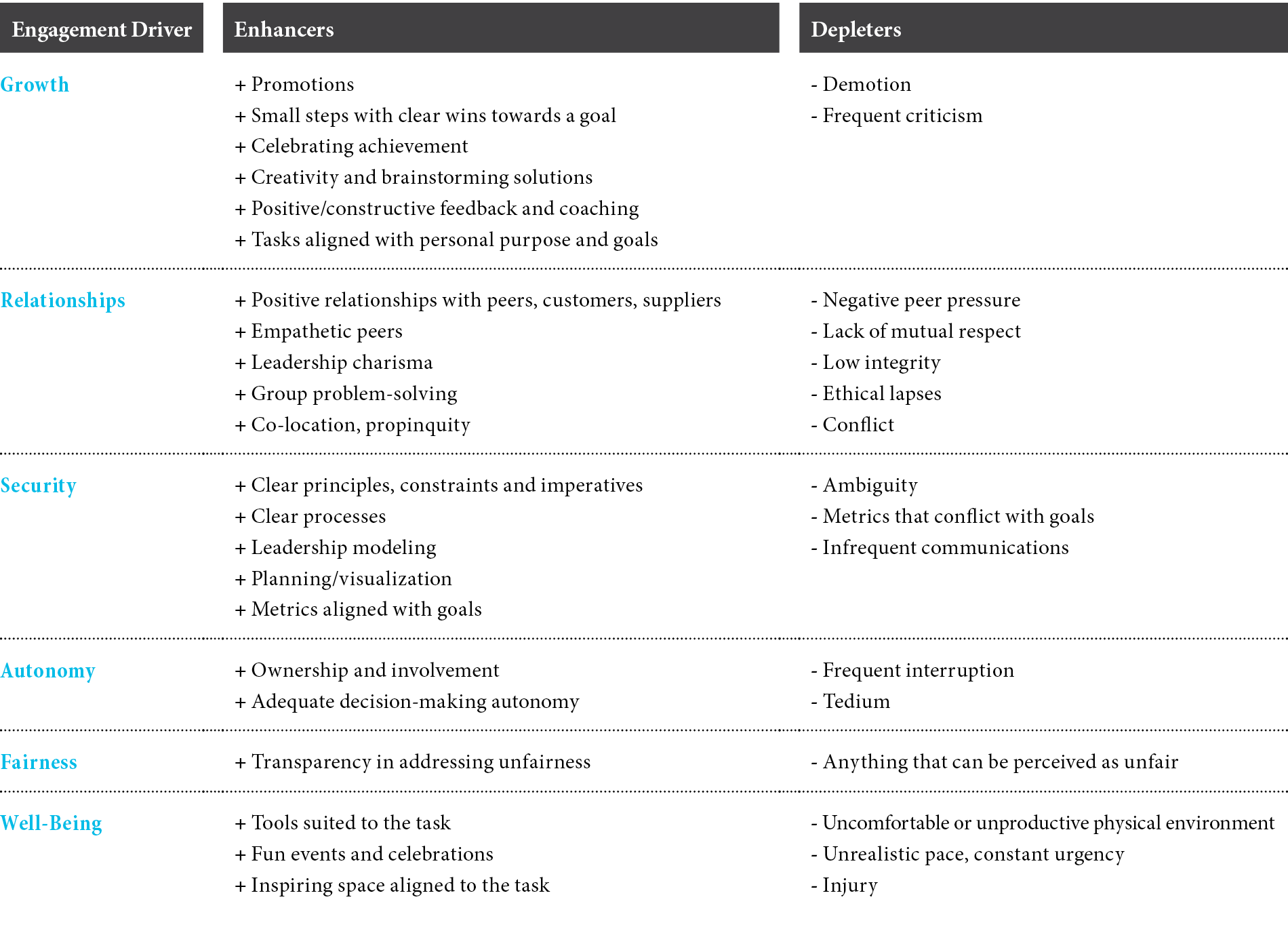Individuals are affected by changes to processes, technology, policies, and organizational structures differently with every change they face. Anything that can influence how individuals approach change is called a engagement driver. Some change levers enhance engagement and promote adoption. Others deplete engagement and drive resistance. The net engagement or resistance an individual, team, or organization exhibits to a change depends on the cumulative effect of all of the change levers across the six engagement drivers.

Engagement Drivers
For each of the six engagement drivers, we describe examples of engagement enhancers and engagement depleters.
Growth
People are motivated by learning something new and interesting, mastering a new skill, meeting a goal, achieving a personal best, or moving up the ladder in relation to their peers. Any change that provides people an opportunity to grow enhances energy and engagement for the change. Changes that diminish growth, such as a demotion or any reduction in organizational status, are depleters.
Relationships
Social relationships are a key source of engagement, whether people are introverted or extroverted. Changes that bring people closer together and improve relationships enhance the engagement of the group. Reorganization efforts that break up strong teams, isolate people spatially, or create unnecessary conflict drive negative engagement. These engagement depleters create friction, slowing the pace of adoption of the change.
Security
When people feel secure about their future, they are better able to understand the change and how it will affect them. When people have security in their jobs — and lives — they can fully engage in their organization, showing increased business and personal results. For example, change is less distracting when people don’t feel their job is on the line. Uncertainty is a significant engagement depleter. We are wired to worry about uncertainty and insecurity; leaders should strive to make things as clear as possible to enhance engagement.
Autonomy
Individuals are motivated by having input into what they work on, how they manage their work, when they work, who they work with, and where they get that work done. Pulling the autonomy lever by increasing freedom and flexibility can be a powerful way to increase engagement. Reduce employees’ decision-making freedom, micro-manage their work, or require tedious work that substitutes for preferred work, and engagement will decrease.
Fairness
Fairness is a very strong engagement driver. Any element of a change that is considered unfair will create distraction that can bring progress toward adoption to a standstill. The key to this driver is to eliminate any element of a change that could be considered unfair. Addressing anything that has been considered unfair in the past will be a positive influence on engagement. Also, acknowledging part of a change that could be considered unfair is key to establishing trust in your stakeholders and being transparent throughout the change process. Fairness is often in the eye of the beholder; be as granular as possible in your analysis of this driver, even as far down as the individual stakeholder. Keep in mind that fairness has an upper limit. Once a change is considered completely fair, it can’t be “more fair.”
Well-Being
This engagement driver encompasses health, both in mind and body. It also incorporates rest and fun. A workforce that is sleep-deprived, unhealthy, and rarely laughs is one where engagement is hard to come by. Encouraging healthy habits, a rested workforce, and an enjoyable work environment will enhance engagement in an organization.

Engagement Pulse Check
By assigning positive and negative values to the engagement levers along a spectrum, change leaders can quickly evaluate the qualitative likelihood of engagement or resistance to a change (see Figure 2). If the change will increase an individual’s or group’s view on Growth, you would show a positive inclination in that category. The size of the bar depends on the value you assign to that driver. Assign a positive or negative value to each engagement driver, average the values, and determine an overall engagement score for each stakeholder group or individual. This engagement score will tell you what level of resistance or adoption you might expect during the change process. The visual representation of the positive and negative engagement drivers clearly illustrates which levers to push and pull to most effectively influence engagement and increase adoption of a particular change. It can also help change leaders build transparency into the process, showing which aspects of the change may be undesirable, and how to best communicate the effect of that change.

What About Engagement Not Related to a Change?
While these engagement drivers apply to specific changes, they can also apply to the overall culture and engagement of the workforce at any time. For example, for an employee who seems to be struggling, develop a list of questions and suggestions based on the engagement drivers. That exercise can help you identify the levers you can adjust to increase satisfaction and long-term engagement. Or, if you want to improve organizational benefits, use this framework to assess what your employees value and appreciate about the organization, then find the right levers to pull to improve morale, drive positive culture change, and drive higher employee engagement.
